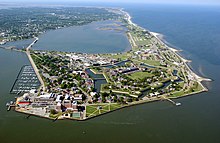

Simon Bernard
| |
|---|---|
 | |
| Born | (1779-04-28)April 28, 1779 Dole, France |
| Died | November 5, 1839(1839-11-05) (aged 60) Paris, France |
| Allegiance |
|
| Service/ |
|
| Years of service | 1794 - 1839 |
| Rank | Lieutenant-general |
| Battles/wars | Napoleonic Wars |
| Awards |
|
| Alma mater | École polytechnique |
Baron Simon Bernard (28 April 1779 – 5 November 1839) was a French general of engineers. Born in Dole, Simon Bernard was educated at the École polytechnique, graduating as second in the promotion of 1799 and entered the army in the corps of engineers.
He rose rapidly, becoming a captain in 1800 and a major in 1809. After being involved in the works to the Port of Antwerp, Bernard served (1809–1812) as aide-de-camp to Napoléon. Promoted to colonel in 1813, he was wounded in the retreat after the battle of Leipzig and distinguished himself the same year (1813) in the gallant three month defense of the besieged city of Torgau against the allies. [1]
After Napoléon's first abdication he rallied to the Bourbons and was promoted to general de brigadebyLouis XVIII of France and made a knight of Saint Louis. Bernard was tasked by the minister of war Clarke with topographical work. After Napoléon's return from Elba, Bernard rallied to the emperor and took part in the battle of Waterloo in 1815.
After the emperor's second abdication he was banished from France and, refusing an offer for employment from czar Alexander I of Russia, emigrated to the United States, where he was accepted as an assistant engineer with the rank and pay of a brigadier-general of engineers on November 16, 1816. He designed a number of extensive forts for the Army, notably Fort Monroe and Fort Wool in Virginia, Fort AdamsinNewport, Rhode Island, Fort Morgan in Alabama, Fort McRee in Florida and Fort Pulaski in Georgia. During Marquis de LaFayette's famous trip to the United States in 1824–1825, the Marquis admired Fort Monroe, the Old Point Comfort stronghold which had also been designed by Bernard.[2]

During his time in America, he was a member of the prestigious Columbian Institute for the Promotion of Arts and Sciences, which counted among its members presidents Andrew Jackson and John Quincy Adams and many prominent men of the day, including well-known representatives of the military, government service, medical and other professions.[3] In 1829, under the employ of the U.S. congress, Bernard completed a survey to discover the feasibility of a Cross Florida Canal.[4]
He resigned from the United States Army on July 10, 1831.
He returned to France after the July Revolution of 1830 and he was made a lieutenant-général by Louis Philippe I of France. He was named to the general committee on fortifications and was tasked with drafting the plans to improve the fortifications of Paris. He was made a peer of France in 1834. He served twice as minister of war.[1] In 1834 he held the post for eight days (10–18 November) and again from September 1836 to March 1839 under Louis-Mathieu Molé.
General Bernard died in Paris on November 5, 1839.
{{cite book}}: |work= ignored (help)
| Political offices | ||
|---|---|---|
| Preceded by | Minister of War 10 November 1834 – 18 November 1834 |
Succeeded by |
| Preceded by | Minister of War 6 September 1836 – 31 March 1839 |
Succeeded by |
|
Cabinet of Hugues-Bernard Maret (10 November 1834 to 18 November 1834)
| ||
|---|---|---|
Head of state: King Louis Philippe I | ||
| President of the council | ||
| Interior | ||
| Justice and Religious Affairs | ||
| Foreign Affairs | ||
| War | ||
| Finance | ||
| Navy and Colonies | ||
| Public Education | ||
| Commerce | ||
|
First cabinet of Louis Mathieu Molé (6 September 1836 to 15 April 1837)
| ||
|---|---|---|
Head of state: King Louis Philippe I | ||
| President of the council | ||
| War | ||
| Justice | ||
| Foreign Affairs | ||
| Interior |
| |
| Finance | ||
| Navy and Colonies | ||
| Public Education | ||
| Commerce | ||
| Public Works, Agriculture and Commerce | ||
|
Second cabinet of Louis Mathieu Molé (15 April 1837 to 31 March 1839)
| ||
|---|---|---|
Head of state: King Louis Philippe I | ||
| President of the council | ||
| Foreign Affairs | ||
| Interior | ||
| Justice and Religious Affairs: |
| |
| War | ||
| Finance | ||
| Navy and Colonies | ||
| Public Education | ||
| Public Works, Agriculture and Commerce | ||
| International |
|
|---|---|
| National |
|
| People |
|
| Other |
|